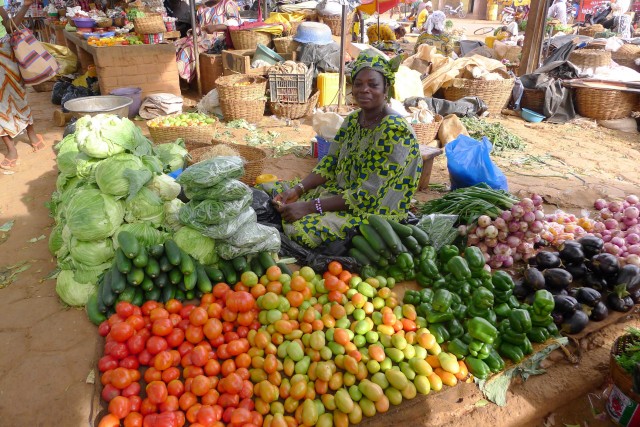Markets
The open-air market is an important feature of African life in both rural and urban areas. As centers of commerce where cash and barter transactions take place, they play a key role in the economy. Most African agricultural products and craft goods enter the system of exchange at local markets, alongside imported products. Tailors, barbers, carpenters, and other tradesmen come to market to sell their services. Markets also serve as community centers where people socialize and share news and information.
In small settlements, they are often located next to important buildings such as the chief's house or the court.

Traditional Markets
Across sub-Sarahan Africa, nearly every community has a market of some kind. Most take place outdoors in open spaces. Sellers squat behind their baskets of goods or display their wares in temporary shelters made of branches roofed with palm leaves or grass thatch. Only in some large towns do markets contain permanent, concrete vendors' stalls.
Though generally crowded, markets are usually well organized. Authorities charge fees to vendors and supervise the pricing of goods. Certain areas of the market may be devoted to particular kinds of products, such as vegetables or cloth, so buyers can easily find and compare all available wares. The number of buyers and sellers at a market ranges from a handful in tiny rural settlements to thousands in the bustling marketplaces of Africa's great cities. Resembling strips of open shops, large urban markets often develop into permanent shopping streets. Most commerce in rural North Africa takes place in traditional markets called suqs. Each suq is held on a specific day of the week and takes its name from the day and from the group on whose territory it is held. In larger towns, the suq is a more permanent feature. It serves as a meeting-place for nomads, townspeople, and traders bringing goods that are not produced locally.
Market Cycles and Traffic
Large urban markets are busy every day. However, most rural markets operate on a periodic schedule, which ranges from opening every other day to opening every seventh or eighth day. In any given district, a group of periodic markets may function as a ring or cycle. An eight-day ring, for example, might include seven markets in different locations, each open on one day. A day on which there is no market completes the cycle. When markets are set up in an eight-day ring, markets held on successive days are usually far apart in the market region. For example, the first market might be in the center of the region, the second in the far south, and the third in the far north. This ensures that no town in the market area ever goes more than three days without having a market open nearby.
On market day, streams of vendors and traders move to and from marketplaces, walking or riding on bicycles or in trucks. Many are women, carrying goods on their heads. A study of one market ring showed that on each market day, as many as 5,000 women—30 percent of the total population of the region—visited that day's market. In a week, a woman might travel a total of 50 miles to various markets. Changes in African life may alter the market's role. As increasing numbers of Africans move into urban centers, they obtain more of their goods from stores and European-style shopping centers. Improvements in the mass transport of goods have made local markets less important in the selling of major cash crops such as coffee. However, with their unique combination of social and economic functions, it is unlikely that open-air markets will ever disappear from African cities and towns. (See also Trade.)